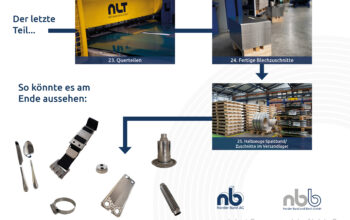Eine Reise endet – Wertschöpfungskette Teil 4

Hier seht ihr die größere unserer beiden Querteilanlage in Aktion
Auf einer Querteilanlage werden die Coils in Breiten zwischen 130 und 1500 mm auf eine Abwickelhaspel gesetzt und abgerollt. Ziel ist es, die Coils nach Kundenvorgabe auf eine definierte Länge abzulängen. Die so entstehenden Produkte heißen „Zuschnitte“ oder „Fixformate“. Sie werden vom Kunden auf Maß bestellt und helfen ihm dabei, zusätzliche Arbeitsschritte durch Nachschneiden und dadurch seinen Schrottanteil zu minimieren oder gänzlich zu vermeiden. Es gibt bei uns auch sogenannte Standardformate. Das sind Bleche, die es in Standardbreite und Standardlänge im Verhältnis 1 zu 2 gibt. Standardformate gibt es in den Maßen 1000 x 2000 mm, 1250 x 2500 mm und 1500 x 3000 mm.
Nach dem Abrollen wird das Band mit einer quer über die Oberfläche laufenden Bürste nochmals abgebürstet, um Staub von der Oberfläche zu entfernen. Das ist besonders dann wichtig, wenn die Oberfläche, wie hier im Video zu sehen, gebürstet und geschliffen wurde. Andernfalls könnten Reste vom Schleifstaub auf der Oberfläche bleiben, die dann im Richtgerüst zu Abdrücken oder Beulen führen könnten. So gereinigt geht es jetzt in ein 21-Rollen-Richtgerüst. Dort wird regelrecht durchgewalkt. Es wirkt darin fast wie gewellt. Aber durch die spezielle Anordnung der 21 Rollen kommt es am Ende als Band, absolut plan und eben, aus dem Richtgerüst. Daher kommt der Name.
Danach geht es auf der Anlage regelrecht rund…oder eher gesagt elliptisch weiter. Die gelb lackierte Schere fährt dabei nach einem Schnitt etwas schräg nach oben, verharrt dort für einen vorher berechneten Moment, um dann ihre elliptische Drehung fortzuführen und zum genau vorgesehenen Zeitpunkt den nächsten Teilungsschnitt zu setzen. Die definierte Zeit für diese elliptische Bewegung führt am Ende dazu, dass der Zuschnitt genau die Länge bekommt, die er haben soll. Jetzt ist aus einem Band ein Zuschnitt geworden, der einer nach dem anderen über das Förderband zur Stapelbox fährt. Dort wird der Zuschnitt durch ein spezielles gelochtes Transportband durch Unterdruck angesaugt, wird „hängend“ über die bereitstehende Palette gebracht und fällt dann von der Luft gebremst auf die Palette. Dort werden die Zuschnitte materialschonend gestapelt, bis die Stückzahl der Palette erreicht wurde.
Die fertige Palette fährt über einen Rollengang seitlich aus der Anlage. Das kann sich doch sehen lassen. Sauber gestapelt – Zuschnitt für Zuschnitt. Jetzt ist sie bereit für die Verpackung und Kennzeichnung, um dann ihren Weg zum Kunden anzutreten.
Es gibt hier im Haus zwei weitere Anlagen, auf denen wir ähnliche Produkte herstellen. Auch diese werden nach dem Spaltvorgang auf eine definierte Breite gerichtet und auf Länge gebracht. Diese Produkte sind meist schmaler. Das ist dann sogenannter Stabstahl. Dieses Produkt stellen wir euch jedoch ein anderes Mal vor.
Ihr möchtet mehr von unseren Anlagen sehen? Wir freuen uns auf eure Wünsche in den Kommentaren.
__________________________
Here you can see the larger of our two cut-to-length lines in action
On a cut-to-length line, the coils in widths between 130 and 1500 mm are placed on an unwinding reel and then unrolled. The goal is to cut the coils to a defined length according to customer specifications. The resulting products are called “blanks” or “fixed formats”. Customers order them to size, helping them minimize or completely avoid additional work steps through re-cutting and thus reducing their scrap rate. We also offer so-called standard formats. These are sheets that are available in standard width and standard length in a ratio of 1 to 2. Standard formats are available in the dimensions 1000 x 2000 mm, 1250 x 2500 mm and 1500 x 3000 mm.
After unrolling, the strip is brushed again with a brush running across the surface to remove dust from the surface. This is particularly important if the surface has been brushed and sanded, as can be seen here in the video. Otherwise, remnants from the sanding dust could remain on the surface, which could then lead to marks or dents in the levelling frame. Cleaned in this way, it now goes into a 21-roller levelling stand. There it is literally rolled through. It almost looks wavy inside. But due to the special arrangement of the 21 rolls, it comes out of the levelling stand as a strip, absolutely flat and even. This is where the name comes from.
After that, the line continues in a round shape… or rather an elliptical shape. After a cut, the yellow-painted scissors move upwards at a slight angle, remain there for a precalculated moment and then continue its elliptical rotation to make the next division cut at the precisely scheduled time. The defined time for this elliptical movement ultimately results in the cut having exactly the desired length. A strip has now become a blank, which one after the other travels over the conveyor belt to the stacking box.
There, the blank is sucked in by a special perforated conveyor belt by vacuum, is brought „hanging“ over the waiting pallet and then falls onto it, slowed down by the air. There, the blanks are stacked in a material-friendly manner until the pallet’s quantity is reached. The finished pallet leaves the system via a roller conveyor at the side. Neatly stacked – cut by cut. Now it’s ready for packaging and labelling before it is sent on its way to the customer.
There are two other lines here in the company on which we manufacture similar products. These are also straightened to a defined width and cut to length after the slitting process. Usually, these products are narrower. This is known as steel bar. We will introduce this product to you another time.
Would you like to see more of our systems? We look forward to your requests in the comments.